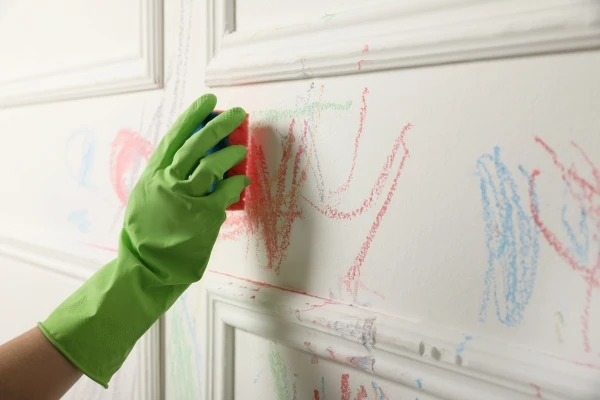
Molly Maid offers this expert advice for cleaning walls to keep your home fresh and spotless.
|
We clean our bedrooms, bathrooms, kitchens, and family rooms, but we may never think to clean our walls. Yet, cleaning walls should be a part of everyone’s regular cleaning routine. Painted walls should be dusted and cobwebs removed at least monthly. Of course, large splatters and crayon scribbles should be cleaned immediately.
Plan to clean your painted walls about once a year, and follow the directions below to avoid damaging the paint. Here is a comprehensive guide on how to clean walls.
Table of Contents:
Step-by-Step Guide for Cleaning Your Walls
1. Prepare for Wall Cleaning
Start with some planning and gather the following supplies:
Cleaning Supplies:
- One broom (or duster)
- One bucket
- One sponge
- Bristle brush (for concrete walls)
- Baking soda
- Ammonia
- Dish soap
Important Note: Before applying your cleaning solution to the entire wall, it’s crucial to test it on a small, inconspicuous area first. This will help you ensure that the solution won’t damage the paint or finish. Allow the test area to dry completely before proceeding with cleaning the rest of the wall.
2. Dust and Clean Your Walls
Before washing your walls, take these steps to remove dust:
- Remove Dust: Use a long broom or duster to reach high places and clear away cobwebs and dust from all surfaces. Microfiber cloths can be used for more easy-to-reach places.
- Vacuuming: A vacuum with a long attachment (6 to 8 feet) is effective for removing dust from corners and high areas.
- Check for Visible Dust: Ensure all visible dust is removed to prevent it from mixing with your cleaning solution.
3. Prepare Your Wall Cleaning Solution
Choose the right cleaning solution based on your wall type and finish:
- For Painted Walls:
- Matte, Flat, Eggshell, or Satin Finishes: Mix a small amount of dye-free hand soap or dish soap in warm water. Natural ingredients like baking soda and rock salt are also effective.
- Glossy and Semi-Gloss Finishes: Use a cleaner with a degreasing agent, such as stronger dish soap or a nonabrasive multipurpose cleaner.
- Oil-Based Paints: Mix 1 teaspoon of all-purpose cleaner with 1 quart of warm water. Have a second bucket filled with clean water ready for rinsing.
- For Non-Painted Walls (e.g., Concrete or Tile):
- Use a stronger solution, such as trisodium phosphate mixed with warm water, or a blend of vinegar and baking soda for cleaning concrete.
- For tile walls, a solution of equal parts vinegar and water can be effective for regular cleaning.
4. Spot Clean for Wall Stains
For specific stains, follow these methods:
- Scuff Marks, Stains, or Crayon: Dampen a microfiber cloth with a mixture of water and baking soda to gently scrub the area.
- Greasy Stains: Use rock salt on a brush to gently rub away grease.
- Smoke Residue: For smoke stains, create a solution of equal parts vinegar and water. Apply it to the stained area with a sponge and gently scrub. You may need to repeat this process for stubborn smoke stains. After cleaning, rinse the area with clean water to remove any residue.
- For Painted Areas Around Door Knobs and Baseboards: Apply rubbing alcohol to a sponge to remove dirt. For tougher stains, mix 2 tablespoons of a mild abrasive cleaner (like borax) into your cleaning solution.
5. Wipe the Washed Wall Surface
To clean the walls thoroughly:
- Gentle Cleaning: Use lukewarm water mixed with mild soap. Gently rub the area in a circular motion with the sponge.
- Rinse: Use a damp cellulose sponge to rinse the walls thoroughly, ensuring no soap residue is left behind.
Special Directions for Cleaning Painted Walls
When cleaning painted walls, it’s essential to be gentle to preserve the finish. Here are some specialized tips:
- Use the Right Cleaning Solution: Choose a cleaning solution based on the type of paint finish. As mentioned earlier:
- For matte, flat, eggshell, or satin finishes, use a mild solution of dye-free soap in warm water.
- For glossy and semi-gloss finishes, opt for a degreasing cleaner.
- For oil-based paints, a solution of all-purpose cleaner mixed with warm water is effective.
- Gentle Application: Use a soft sponge or cloth to apply the cleaning solution. Avoid abrasive materials that can scratch or damage the paint.
- Work in Sections: Clean one section at a time, rinsing the sponge regularly to avoid spreading dirt around.
- Dry the Walls: After cleaning, use a soft, dry cloth to gently wipe the walls. This helps to prevent water spots and keeps the paint looking fresh.
- Avoid Excessive Water: Be cautious not to soak the walls, as excess moisture can seep behind the paint and cause damage.
Special Directions for Cleaning Concrete Walls
Concrete walls require specific techniques due to their porous nature. Follow these guidelines for effective cleaning:
- Choose a Suitable Cleaner: For concrete, you can use stronger cleaning agents like trisodium phosphate or a mix of vinegar and baking soda.
- Soak the Cleaning Solution: Allow the cleaner to soak into the concrete surface for a few minutes. Stronger cleaners may only need a minute or two, while natural solutions can be left for up to an hour.
- Scrubbing Technique: Use a bristle brush for scrubbing, applying firm pressure to dislodge dirt and stains. Make sure to scrub in a circular motion to ensure thorough cleaning.
- Rinse Thoroughly: After scrubbing, rinse the walls with clean water to remove any remaining cleaning solution, preventing residue buildup.
- Drying: Use a fan or hairdryer to help dry the cleaned area, especially if it’s in a damp environment. This step is important to prevent mold and mildew growth.
By following these special directions, you can maintain the integrity of both painted and concrete walls while ensuring they stay clean and fresh!
How to Clean Bathroom Walls and Showers
To achieve sparkling clean bathroom walls and showers, it’s essential to use the right cleaning solutions tailored to the surfaces you’re cleaning.
For Tile or Natural Stone Walls:
Create a cleaning solution by mixing equal parts of white vinegar and water in a spray bottle. Simply spritz the solution onto the surfaces and wipe them dry with a clean cloth or sponge to remove soap scum and stains effectively.
For Water Stains on Bathroom Walls and Counters:
To tackle stubborn water stains, dampen a sponge with a mixture of ½ cup of vinegar, ¼ cup of baking soda, and ½ gallon of water. Gently scrub the affected areas with the sponge, allowing the mixture to sit for a few minutes before wiping it clean for best results.
These simple solutions will help keep your bathroom walls and showers looking fresh and clean!
How to Clean Mold and Mildew Off Walls
Cleaning mold and mildew from your walls is essential to maintaining a healthy home environment. For effective removal, prepare a solution consisting of 50% bleach and 50% water. This mixture is crucial because bleach effectively kills mold spores and helps prevent them from spreading to other areas of your home.
Safety Precautions:
Since bleach is a corrosive chemical, always wear gloves and eye protection while cleaning. Additionally, take care to avoid getting the solution on other surfaces, especially in rooms with carpet or wood floors.
Application:
Using a plastic spray bottle for your bleach solution allows for better control over where the solution lands. Spray the affected areas generously and let it sit for a few minutes to ensure the mold is fully treated.
Drying and Prevention:
After cleaning, use a hair dryer or a fan to dry the area thoroughly. Consider repainting the cleaned area with mold and mildew-resistant paint to help prevent future growth. Following these steps will help keep your walls clean and free from mold and mildew!
How Molly Maid can Assist with Your Other Cleaning Needs
If you need help cleaning other parts of your home, the cleaning professionals at your local Molly Maid can help. Whether you need regular cleaning, occasional cleaning, or a one-time visit, we offer cleaning plans that will meet your needs and make your house sparkle. To schedule a free in-home estimate, give us a call or request an estimate online today.
Wall Cleaning FAQ
How often should I clean my walls?
It's recommended to clean your painted walls at least once a year. Additionally, you should dust and remove cobwebs monthly, and clean up large stains or spills immediately.
Can I use bleach to clean my walls?
Yes, you can use a bleach solution (50% bleach and 50% water) to clean mold and mildew from walls. Ensure to wear gloves and eye protection and test on an inconspicuous area first.
How do you clean walls without ruining paint?
Use a gentle cleaning solution suitable for your wall type, test it in an inconspicuous area first, and apply it with a soft sponge to avoid damage.
Can you use Swiffer wet pads on walls?
Yes, Swiffer wet pads can be used on walls for light cleaning. Ensure to test a small area first to ensure it doesn't damage the paint.
Is it safe to clean painted walls with vinegar?
Yes, vinegar is generally safe for cleaning painted walls. However, it's important to dilute it with water and test it on a small area first.
How do professionals clean walls?
Professionals typically use specialized cleaning solutions, dusting equipment, and techniques tailored to the wall type and condition. They may also utilize tools like steam cleaners for deep cleaning.
